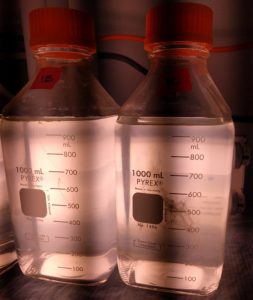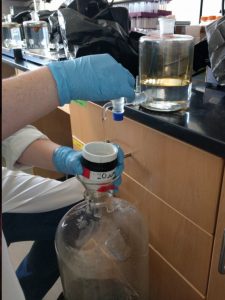Study Identifies Phytoplankton Species as Resistant or Sensitive to Oil Spills
– OCTOBER 29, 2019
Researchers examined the biological and physiological response of phytoplankton to oil and oil plus dispersant in laboratory experiments. They observed that responses were species-dependant and grouped those whose growth was severely affected by oil as “sensitive” and those with little to no effects as “resistant.” Neither treatment inhibited the photosynthetic efficiency of phytoplankton, except at the highest dispersant concentration, even for species identified as sensitive, which raises questions concerning the method of measuring photosynthesis to detect oil-exposed phytoplankton. The results have implications on how oil spills might affect phytoplankton community structure and bloom dynamics in the Gulf of Mexico, which in turn could affect higher trophic levels.
The authors published their findings in the Journal of Phycology: Physiological response of 10 phytoplankton species exposed to Macondo oil and the dispersant, Corexit.
A number of studies investigating impacts following Deepwater Horizon focused on deep-sea bacterial communities, but there is little known about ecotoxicological effects on phytoplankton. This study sought to provide information that would help scientists make insightful choices into which phytoplankton species would be ideal candidates for further research.
“Phytoplankton are crucial to the health of the ocean since they form the base of the food web in most marine ecosystems,” explained study author Laura Bretherton. “Different types of phytoplankton have different functions in the environment. Some groups are able to grow very quickly and can form what are known as “blooms,” where their numbers become incredibly high when the conditions are just right. These blooms are important annual events that support a lot of marine life.”
The team prepared several exposure cultures: water accommodated fractions (WAF) of MC252 Louisiana crude oil (Macondo surrogate oil); a chemically-enhanced WAF (CEWAF) using a 1:20 COREXIT-oil ratio; and a diluted CEWAF (DCEWAF). Then they observed the effects on the growth kinetics and photophysiology of ten phytoplankton species/strains – from cyanobacteria and chlorophytes to centric and pennate diatoms – that are ecologically significant to the Gulf of Mexico.
“Our oil concentrations in the WAF and DCEWAF treatments were within the range detected at various sites around the Gulf,” explained Bretherton. “The DCEWAF treatment is our way of accounting for dispersed oil that will dilute in the natural environment. We tried to match the concentrations in the WAF and DCEWAF so they are comparable, with the CEWAF serving as a more “extreme” example for toxicity.”
Results showed that “robust” phytoplankton are Synechococcus elongatus, Dunaliella tertiolecta, two pennate diatoms (Phaeodactylum tricornutum and Navicula sp.), and Skeletonema grethae CCMP775. Consistent with the findings for Synechococcus elongatus, cyanobacteria have shown resistance to oil exposure in previous studies. However, cyanobacteria did not contribute much to surface bacterial communities immediately following Deepwater Horizon and may not be significant components of post-spill bacterial communities.
Phytoplankton identified as “sensitive” were all centric diatoms and exhibited at least some combination of reduced growth rates or increased lag time in response to oil and/or dispersant exposure. The most sensitive species exhibited severe inhibition to accumulate biomass in every treatment. Decreases in growth rate across all treatments were only observed in Thalassiosira pseudonana, Skeletonema grethae CCMP776, and Skeletonema costatum. Lower biomass caused the increase in lag phase duration, suggesting that growth rate may not always be an effective tool to identify sensitive species.
“Our study tells us a couple of things about the way oil affects phytoplankton,” explained Bretherton, “It gives us an idea that different groups of phytoplankton react differently to being exposed to oil, which means we might expect to see changes to the phytoplankton community structure following a spill. It also tells us that taking measurements of photosynthesis might not be an effective tool in detecting whether or not phytoplankton have been exposed to oil. We found that a few important bloom species were quite sensitive to oil. Different kinds of phytoplankton also have different nutritional value for the small animals that eat them, so while changes to the phytoplankton diversity might be bad for some of these creatures, it could be beneficial for others.”
Building upon this research, the authors published a subsequent study that suggested dispersed oil, but not oil alone, can stop phytoplankton growth and decrease their photosynthetic efficiency.
Data for this study are publicly available through the Gulf of Mexico Research Initiative Information & Data Cooperative (GRIIDC) at DOI 10.7266/N79P2ZPD.
The study authors are Laura Bretherton, Alicia Williams, Jennifer Genzer, Jessica Hillhouse, Manoj Kamalanathan, Zoe V. Finkel, and Antonietta Quigg.
By Nilde Maggie Dannreuther. Contact maggied@ngi.msstate.edu with questions or comments.
************
This research was made possible in part by grants from the Gulf of Mexico Research Initiative (GoMRI) to the Aggregation and Degradation of Dispersants and Oil by Microbial Exopolymers (ADDOMEx) consortium.
The Gulf of Mexico Research Initiative (GoMRI) is a 10-year independent research program established to study the effect, and the potential associated impact, of hydrocarbon releases on the environment and public health, as well as to develop improved spill mitigation, oil detection, characterization and remediation technologies. An independent and academic 20-member Research Board makes the funding and research direction decisions to ensure the intellectual quality, effectiveness and academic independence of the GoMRI research. All research data, findings and publications will be made publicly available. The program was established through a $500 million financial commitment from BP. For more information, visit https://gulfresearchinitiative.org/.
© Copyright 2010-2019 Gulf of Mexico Research Initiative (GoMRI) – All Rights Reserved. Redistribution is encouraged with acknowledgement to the Gulf of Mexico Research Initiative (GoMRI). Please credit images and/or videos as done in each article. Questions? Contact web-content editor Nilde “Maggie” Dannreuther, Northern Gulf Institute, Mississippi State University (maggied@ngi.msstate.edu).







